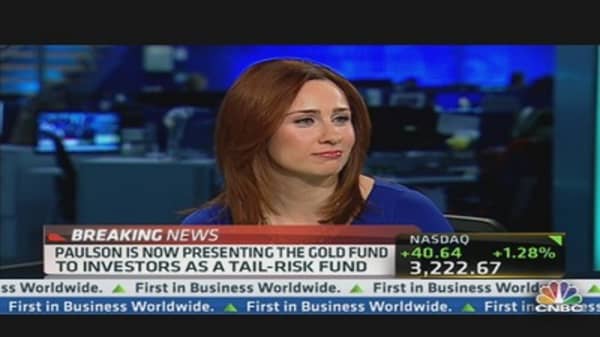Paulson & Co. initiated its gold thesis in April 2009, shortly after the Federal Reserve announced plans to add $1 trillion to the financial system by purchasing longer-dated Treasury bonds and mortgage-backed securities. Gold was trading at less than $1,000 at the time.
Rather than buying physical bullion, though, Paulson bought a combination of gold-mining equities, including AngloGold Ashanti and Gold Fields. Given the quantity of yellow metal in their proven reserves and the relatively low valuations at which they were trading, stocks like AngloGold seemed a cheap entry point for a metal trading at far higher levels in the commodities markets, Paulson and his gold team believed.
(Read More: John Paulson Still Bullish on Economy, Housing)
In the intervening years, gold ran way up—to an all-time high of more than $1,900 in Sept. 2011. Throughout that period, Paulson toyed with the mix of mining and production stocks and a small portfolio of gold derivatives, also housed in the gold fund. But, confident of his longer-term thesis, Paulson left the overall strategy intact.
That resilience has created lots of pain of late. Ballpark estimates gleaned from Paulson's securities filings and stock prices during those periods suggest that of the six major gold-mining and production equities Paulson has held for 12 or more quarters—names like AngloGold, Gold Fields, and Barrick Gold—almost all are down by double-digit percentages since he bought them (one name, Iamgold, has fallen 60 percent). At the same time, though, gold itself has risen by an even bigger margin.
(Read More: Can Gold Stocks Regain Their Luster?)
Despite the troubles, John Paulson has no plans to close down the gold fund, said the person familiar with the matter, and will play out his three-to-five year thesis regardless of any short-term issues. "I think as long as the Fed is buying, that's going to be positive for the gold price," Paulson said at a presentation at Manhattan's 92nd Street Y cultural center in January.
Volatility, however, is likely to continue—and with it, a dose of investor skepticism.
—By CNBC's Kate Kelly; Follow her on Twitter: @KateKellyCNBC





